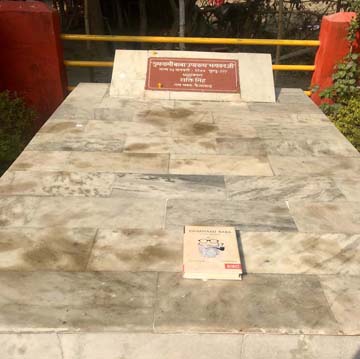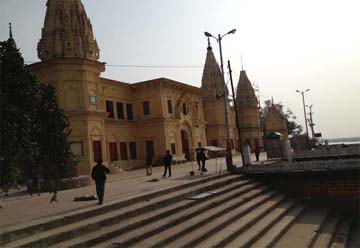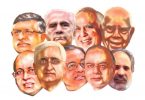The Saint and Shri Ram: a chronicle of coincidences
-By Adheer Som
{The following is an excerpt adapted from the author’s book, Gumnami Baba: a Case History}
January 23, 2015
Faizabad cantonment is home to the Dogra Regiment whose insignia — like the INA’s — is a Tiger, and whose men also fought and died in that forgotten army. A long, pleasant road leads through the forested military encampment to a mythic shore of ancient Saryu. Here lies Guptar Ghat, where Gumnami Baba was secretly cremated on September 18, 1985. It is not a Samshan Ghat (cremation ground). The life-story of only one other man has concluded here and that man was the best of men, the eighth Avatar of Vishnu, Shri Ram himself. In stark contrast to his place of birth, his place of passing is uncontroversial, quiet and beautiful. The river is magnificent, its bank lined with boats, overlooking which stands the tall, yellow-walled Ram-Janaki temple. The adjunct Charan Paduka Mandir enshrines the footprints that Ram left on the stone steps leading to the water, in the depths of which he left mortal coil at the end of his reign. Just a few meters from this sacred spot is Gumnami Baba’s Samadhi: a 6 ft by 3 ft raised platform with headstone and a boundary.
The memorial is about a decade old, prior to which all that marked the location was a rock, with “Anam Sant” (nameless saint) scrawled on it.

How could it be that a literal “nobody” — whose death was the talk of town, whose scene of death in the middle of town was beset with people — was yet somehow “secretly cremated” in the interiors of an Army Cantonment, by a total of 13 civilians, at the same place where Lord Rama took Jal-Samadhi? I paid my respects to the Lord first, then to the saint with no name. It was gladdening to think that if the latter was really Netaji, then Netaji had the best possible company and view at his final resting place, better than all his sainted rivals.

The connection with Ram continued at Ram Bhawan, where Gumnami Baba had lived out his last years as an unseen tenant. The small, squalid quarters he’d occupied are in a corner of the backyard of this large, handsome house in the heart of Faizabad, right across the road from the district’s main government offices. A bust of Bose stands in its lawn. I and the SDM Sahib with me stood before it and saluted. “Jai Hind Janaab” he said. “Happy Birthday, Sir” said I.
The Singhs of Ram Bhawan have long been one of the city’s reputed and influential families. Thakur Guru Dutt Singh, who built and named the house, had been instrumental — as City Magistrate in 1949 — to the appearance of the infant Rama (“Ram Lalla”) idol inside the disputed Babri Masjid structure. The late magistrate’s grandson Shakti Singh — a senior member of the BJP State unit — very kindly showed us around the nameless saint’s one-time quarters.
There wasn’t much to see. The two-room set now has a pucca roof and is the office of Singh’s NGO “Netaji Subhash Chandra Bose Rashtriya Vichar Kendra”. The walls have been repainted and new furniture put in. Only two things remain unchanged: the still-curtained window between the rooms, from behind which the saint spoke to the rare few he allowed into his presence; and the small backdoor in the adjoining boundary wall, which opens onto the densely wooded Dogra Cantonment grounds. A good door to come and go, without being known to do so…
Like Netaji, the saint was known to have been a heavy smoker. Tobacco pipes and imported cigarettes like “555” — unavailable in these parts even today — were found in his belongings. Like Netaji, he was also known to have celebrated his birthday on January 23. Whoever he’d been, I had no reason to presume it wasn’t his birthday so I’d brought a present. With Shakti Singh’s permission I placed the gift —a pair of Romeo y Julieta Churchill Cigars — on the window-sill. As I took my leave, he asked if anything could be done to expedite implementation of the High Court’s 2013 judgment in the saint’s case (of which Singh is the last living petitioner). I assured him I would do everything I could.
Interestingly, when the petition was filed in the case back in late January 1986 by Netaji’s niece Lalita Bose, the mystery monk seemed destined to hit not just national but worldwide headlines. There seemed no story half as historic around which could move the spotlight from the story of the strange, nameless saint who might once have been Subhas Chandra Bose… Yet, not only did the spotlight move away almost overnight, it moved away due to something historic that happened in Faizabad itself. As Lalita Bose was filing her petition asking to establish the saint’s identity, in the Lucknow Bench of the High Court, another petition was being filed at Faizabad Sessions Court for opening the long-shut main gates of ‘Ram Janmbhoomi.’ On February 1, 1986, the District Judge ordered the unlocking of the site. On the February 10, Justices Sageer Ahmed and G.B. Singh ordered U.P. Government to inventory and shift the saint’s material to the Treasury, pending inquiry. By then Gumnami Baba was no longer the news, having been supplanted by Shri Ram himself.
December 6, 2017
They say there’s a time and place for everything. As I write this, the Gumnami Baba Galleries are ready and awaiting inauguration, where else, but at the Ram–KathaSangrahalaya, Ayodhya.
No wonder they also say, Sab Ram Ji ki Leela hai.
CLICK HERE to Know More or Buy Online





